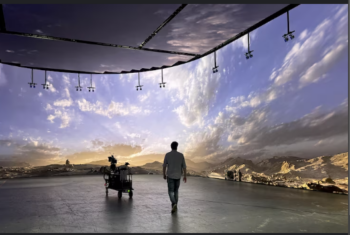
If you’re reading this, you’re probably looking to make a training video.
Chances are, it’s for your employees, members of your organisation, or users of your service or product.
You probably already know that video training is a valuable avenue to consider when creating training content, especially as research shows that students retain more information from video than they do from other delivery methods.
In this post, we’ll provide you with ten types of training videos to consider and share why they would be useful training content for your company or organisation.

- Why businesses train staff in the first place
- So, Why Training Videos?
- Video Versus Written Information: A Case Study
- What Makes A Good Training Video?
- #1 The ‘Classic’ Presenter Training Video
- #2 Roleplay Training Video
- #3 Interactive Training Video
- #4 Explainer Training Video
- #4 Virtual Reality Training Content
- #5 Whiteboard Training Video
- #6 Interview Training Video
- #7 Instructional Training Video
- #8 Animated Training Video
- #9 Software Walkthrough Training Video
- #10 Narrative Training Video
Why businesses train staff in the first place
To get a clear picture of why videos are important for training, let’s start with why businesses train their staff.
There are three main reasons, and they’re all connected:
- Profit;
- Efficiency, and;
- Customer satisfaction.
How are they connected? Well, we train staff so that they can become more efficient, productive, and skilled in a way that aligns with the business’ best practices and regulatory requirements. This focus on equipping staff with the appropriate skills and knowledge gives them the ability to excel at their jobs, which improves the business’s bottom line and in turn gives their customers an excellent and consistent customer experience.
So, Why Training Videos?
It all begins and ends with the capability of employees. So, why video training? Below is a case study to demonstrate.
Video Versus Written Information: A Case Study
A study explored the effect of an educational video on enhancing student retention. In the study, 223 undergraduate nursing students were divided into two groups and received refresher information. The experimental group watched a video that demonstrated a nursing technique. In contrast, the control group read written information, which had the same words and sequence of the video content. The results showed that the experimental group outperformed the control group by 6.19 points. The experimental group scored 42.95 on all items, while the control group scored 36.76.
TL;DR? The classic paper approach to training – written training content – has its place, its pros, and cons, but it’s time for more businesses to make video training content for their staff, customers, and suppliers.

What Makes A Good Training Video?
In our experience, there are four criteria for a good training video. They are;
- The video is anchored to a specific learning objective
- The video is easy to understand (clear visual markers, good pacing, even captions!)
- The video’s relevant and memorable (so they remain evergreen and sticky in people’s minds)
- The video has a logical structure
Without further ado, let’s get into the ten types of training videos!
#1 The ‘Classic’ Presenter Training Video
First up, we have the classic presenter training video. In the industry, we call this style of filming a ‘piece to camera’, meaning that an actor, trainer, or staff member speaks directly to the camera during the video. We call this the ‘classic’ because it simulates an in-person training experience for the viewer. We give bonus points to this one because making your training video presenter-style means that your business does not have to send the trainer to multiple locations to deliver the same training, again and again. This is perfect if you have a specific expert or educator that you’re using as the face of your training.
This type of training video production is incredibly versatile, as it can be used all throughout a course or inter-cut with scenario-based videos (think MasterClass videos). In this project we worked on with Myer, we created a series of training videos with a narrative focus, for staff to learn how to respond in difficult situations. Actors played out different scenarios, and by watching these stories unfold, the staff in training would learn about appropriate ways to respond and care for all involved.
#2 Roleplay Training Video
This type of training video leans into ‘learning through application’ by simulating scenarios that require applied learning. This type of video is effective because it allows the viewer to take in the content and then apply it. While applying roleplaying to video content means that the viewer is not able to actively participate or impact the scene in real-time, we have found multiple ways for the viewer to be interactive and engaged throughout the learning process. Quizzes, discussion questions, and branching interactive decisions in-video are examples of possible ways to create that two-way interaction.
Below is an example of a roleplay training video for Aspire Learning, training staff on how to appropriately approach people living with dementia.
#3 Interactive Training Video
Interactive training video is pretty high on this list because we love its unique ability to allow the viewer to decide what to do next, watch consequences unfold, and see events unfold from different perspectives. Interactive training videos often have in-video buttons or form fields where the viewer can input information that is then graded automatically. Think Duolingo-style learning, within a video. Interactivity makes training more accessible and engaging and simplifies complex training into straightforward and digestible content.
Court Services Victoria sought a creative partner to help develop and deliver online training to support court registrars working on family violence cases around the state. Collaborating with their learning designers, Creativa produced compelling, engaging content to import into their learning management system (LMS).
#4 Explainer Training Video
Borrowing wisdom from the age-old adage ‘show, don’t tell’, explainer training videos allow the viewer to see exactly what needs to be done, learned, or practiced. A classic explainer video explains the problem, the solution, how it works, and lastly, the call to action. Applying this to training, an explainer training video walks the viewer through the important reasons behind the training (i.e. the ‘problems’ we want to avoid), shows a detailed ‘how-to’ do something (i.e. the solution and how it works), and gives the viewer the tools they need to act on this training in a real-world environment.
Explainer-style training videos can be live action, animated, or a mixture of both. The below video is a 3D animated walk-through of a complex medical product, created for staff to watch while they’re in training on the system.
#4 Virtual Reality Training Content
Virtual reality (VR) training videos are excellent for giving staff experience in the most realistic way possible, without actually having them ‘on the ground’. Whether training for first-timers or a refresher course, VR training videos give viewers a new way to immerse themselves in the learning content.
We provided VR training content for a client that needed training that was immersive, realistic, and memorable. Virtual reality was well-suited as it allowed staff to roleplay scenarios that would be difficult to simulate in person, as they relied on acting performance. You might be surprised at how non-technical a VR training setup is – with just a VR headset and the appropriate training video optimised for 360°, you can set your staff up to practice critical thinking and decision-making skills in realistic, simulated interactive experiences.
#5 Whiteboard Training Video
Even though whiteboard animation is not new (the YouTube ‘Draw my life’ trend, anyone?), it’s still an eye-catching and simple visual. It’s versatility in being able to help communicate complex and straightforward messages makes it a handy tool for business owners. Not only is its application versatile, but the tone of the video can be anything from fun to serious, to corporate.
This is a whiteboard animated marketing video that we made for Monash University, explaining the impact and problems caused by Dengue fever. As you can see, it’s an effective visual for educational content and purposes.
#6 Interview Training Video
If you search for the term ‘interview training video’, no doubt you’ll get a series of hits about how to prepare for an online interview. However, this type of training video is about learning from experts. A Q&A video with a noted speaker, seasoned staff member, or industry expert can be a welcome switch-up in learning content for your staff or users. This format allows experts to share their knowledge, wisdom, advice, and tips with the audience.
In this video for the Australian Education Research Organisation, teachers from Loxton Primary School are interviewed about their approach to explicit teaching.
#7 Instructional Training Video
When it comes to teaching someone important content, oftentimes it’s best to take them through the learning material step-by-step. For teaching moments that require this level of detail, instructional training videos are the perfect fit. If your business has a product, service, or process that your users, customers, or members would benefit from learning more about, you can create instructional training videos to fill up a ‘how-to’ library of useful training content. What’s better than creating evergreen training resources that save your employees time in the long run?
What better to illustrate an instructional training video than a step-by-step recipe walkthrough? Here’s an example of a cooking demonstration video we produced for Health Education Collaborative.
#8 Animated Training Video
An animated video is only as limited as your imagination! It’s a flexible and versatile type of video, because every single element within the video is under the control and direction of the production team and their client. As opposed to being restrained to real-life environments and physical objects/people that you can capture on film, animation lets us bend the rules of reality and create whatever we want. This is really beneficial in training because it means we can make the video exactly as required, with character animations and motion graphic text, and bring to life any concept that would suit the educational content.
In the corporate landscape, animation is often used in explainer videos, used to educate and inform viewers. Here’s a video we made for Calcumate, a tool for businesses and individuals to use to calculate the volume of their items compared to the space they want to fill.
As you can see, we were able to simulate filling up a room with items, something that would have been far more costly and complicated (with a sprinkling of impractical!) to shoot with live action video.
#9 Software Walkthrough Training Video
With software walkthrough training videos you impart critical information to your customers in an uncomplicated way. Creating an educational video for customers allows them to take control of their learning, and increases their sense of ownership of your product. In other words, compelling software walkthrough videos help turns your customers into brand (and product!) ambassadors. Sharing important product workflows, mastering interfaces, and introducing new features? Software walkthrough training videos should be your go-to.
Our client Wikicamps launched a new app for their crowd-sourced camping travel tool. With their app, hundreds of campsites are in their customer’s pockets. We produced an engaging and comprehensive walkthrough of their product and its interface to attract new customers, as well as to reengage existing customers.
#10 Narrative Training Video
Storytelling is a compelling training method. This is because stories have been our primary communication method for hundreds of years; they connect people to each other, and to their emotions. It helps people to empathise with each other. And to make it even more interesting, studies show that reading – or hearing – stories activate various areas of our brain’s cortex. These are areas known to aid in social and emotional processing. So how do we make training more engaging? Narrative storylines.
This is a narrative-style training video we produced for Sheriff’s Office Victoria, the organisation responsible for actioning warrants in Victoria for both civil and criminal matters. This was part of a set of videos produced to train Sheriff’s Office staff.
The biggest takeaway from this post is that whatever video type you choose, it’s important that you incorporate video into your training strategy. Video is a favourite type of content for customers, with most consumers saying they love video content (and that includes your employees, too!). It increases viewer engagement, which in turn helps boost achievement, among your other learning goals.
For the direct-to-consumer or service brands out there, according to Animoto, 73% of consumers have been influenced by a brand’s social media presence when making purchase decisions. By creating educational content that consumers can view before making a purchase, you’re removing the barriers to purchase.
We create all styles of videos, including animations, screencasts, and live action, that can perfectly fit whatever training video you are looking for.
Book a strategy call with us to get your training content sorted.




